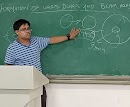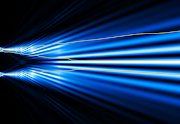Astronomy and Astrophysics
Explaining the Chronology of our Cosmos
As we all know
that big bang model is most accepted model for the creation of our cosmos.
According to that model, it is estimated that this mega event was occurred 13.7
billion years ago. Before that it is believed that our whole universe was in
the form of very very tiny ball. But after the big bang, some serious
chronological events happened without which we wouldn’t see the universe as it
is today.
Here, in this
article, I am going to give you a very brief but informative explanations on
each of the time-period after big bang to till date. In my future follow up
articles, I will explain about each of these stages in detail. You will find
the links for all those detailed articles in this article when all of it will
be uploaded!!!
According to our
current understanding, due to the extreme conditions and the violence of its
very early stages, it saw much more activity and change during the first second
than in all the billions of years ever since. Based on the activity and major
changes in respective time-frames, astronomers divided the total timeline of
universe into 15 stages with their own time-frames.
Stages of
Evolution of Universe:-
We use Plank epoch
to refer time from 0 to 10^-43 seconds (also
known as 1 plank time) after big bang explosion. According to our current
understanding, this is the closest we can get to the explosion where the
current understanding of physics is applicable. Very little can be known about
this period as most of the information of this period have been destroyed. All
we know that the universe spanned a region of only 10^-35 (1 plank length) and all the fundamental
forces of universe was either unified or had same power.
Grand Unification
epoch was from 10^-43 seconds to 10^-36 seconds. It is believed that gravitational
force was separated from the grand unified force while other forces remained
unified and the creation of earliest elementary particles and their antiparticles started.
Inflationary Epoch
was from 10^-36 seconds to 10^-32 seconds. It is believed that it was
triggered by the separation of strong nuclear and in result the universe went
through rapid expansion with acceleration. The elementary particles remaining
from the earlier stage distributed very thinly across the universe.
Electroweak Epoch
was from 10^-32 seconds to 10^-12 seconds. The extreme particle interaction
during this stage created many types of particles like W and Z bosons and Higgs
bosons. Due to the created of Higgs bosons, for the very first time the concept
of mass was introduced in the universe as Higgs field gives the mass to
respective particle.
Quark Epoch was
from 10^-12 seconds to 10^-6 seconds. At this stage, universe was below 10
quadrillion degrees. Quarks and antiquarks were colliding with each other which
results into annihilation. But, surprisingly a surplus of quark survived. Those
surviving quarks ultimately formed the matter we know today. No one knows why
only quarks survived and it’s still a big unsolved mystery in physics. Also,
all the four fundamental forces finally came to their current forms.
Hadron Epoch was
from 10^-6 seconds to 1 second. At this time
the temperature of universe was around 3 trillion degrees. That is cool enough
to form hadrons like protons and neutrons by the combinations of quarks. Production
of neutrinos was also in a high rate due to the continuous collision of
electrons and protons to form neutrons and in the process giving out neutrinos.
The reverse was also happening. Neutrinos and neutrons were also re-combining
to form proton and electron pairs.
Lepton epoch was
from 1 second to 3 minutes. During this time electrons and their antiparticle
positrons collided continuously and in result annihilated each other and also
formed photons. Just like in Hadron epoch, photons in Lepton epoch also
collided to form electron-positron pairs.
Nucleosysnthesis
was from 3 minutes to 20 minutes. At this time, temperature of universe was
about 1 billion degrees which was sufficient to for nuclear fusion and through
this process protons and neutrons were combining to form atomic nuclei. After
20 minutes, nuclear fusion was no longer sustainable.
Photon epoch was from 20 minutes to
240000 years. This was period where the energy of universe was dominated by
photons as most leptons and antileptons annihilated each other. The universe at
that time was filled with plasma and opaque soup of atomic nuclei and
electrons.
10) Recombination and Decoupling:-
This period was from 240000 years to
300000 years after big bang. In this stage, the electrons in universe finally
bounded with nuclei to form atoms as the temperature was about 3000 degrees
which is also same as surface temperature of sun. In this stage, for the very
first time, universe was visible as the opaque soup of electrons and protons
were cleared and photons finally free to move. This is the earliest stage of
universe which we can observe. The leftover heat and photons can be observed
today as Cosmic Microwave Background (CMB). To know what CMB is, you can refer to my book 'Through the Wormhole'.
 |
| Cosmic Microwave Background |
11) Dark Era:-
This period was from 300000 years to
150 million years after the big bang. During this time there were no stars to
give off light. Although photons existed but the universe was truly dark. The
energy level was also very low and there was minimal to no activity throughout
the universe.
12) Reionization period:-
This period was from 150 million to 1
billion years. This phase was triggered by the formation of Quasars due to
gravitational collapse. This phenomena ionizes the surrounding areas of universe.
 |
| Quasar |
13) Early Star and Galaxy Formation:-
 |
| Hubble Deep Field shows us many early stars and galaxies |
This period was from 300 to 500 million
years. During this period the pocket of gases become more and denser due to
gravity and started to collapse under their own gravity and eventually
triggered nuclear fusion creating the very first stars. Gradually, these stars
formed galaxies and due to gravity, galaxies pulls themselves to form clusters
and superclusters.
14)
Formation of our solar system:-
Our solar system formed between 8.5 to
9 billion years after big bang. It was formed by the left over material of
earlier stars.
15) Today’s Universe:-
As I said earlier, in my future follow up articles, I will explain about each of these stages in detail except last 6 steps as they are sufficiently explained here for a beginner. You will find the links for all those detailed articles in this article when all of it will be uploaded....be tune with us!!!
And don’t forget to subscribe to our website and follow me on social media for updates…..
To know basics of quantum world, astronomy and space exploration you can check out my book "Through the wormhole" on amazon kindle.
You can directly talk with me on Instagram
To meet more physics Enthusiasts please join our Facebook Page
Also for latest updates of my posts join me on TwitterTo meet more physics Enthusiasts please join our Facebook Page
Thanks for reading.....
See you next time!!!
-Ratnadeep Das Choudhury
Founder and Writer of The Dynamic Frequency













0 Comments